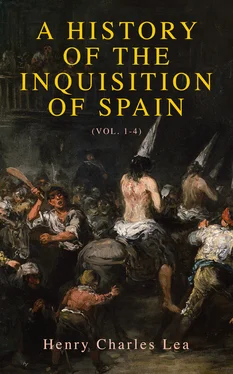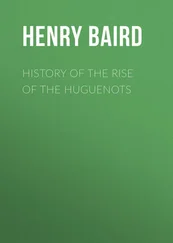ISABELLA
In his successful career as a monarch he was well seconded by his queen. Without deserving the exaggerated encomiums which have idealized her, Isabella was a woman exactly adapted to her environment. As we have seen, the muger varonil was a not uncommon development of the period in Spain, and Isabella’s youth, passed in the midst of civil broils, with her fate more than once suspended in the balance, had strengthened and hardened the masculine element in her character. Self-reliant and possessed of both moral and physical courage, she was prompt and decided, bearing with ease responsibilities that would have crushed a weaker nature and admirably fitted to cope with the fierce and turbulent nobles, who respected neither her station nor her sex and could be reduced to obedience only by a will superior to their own. She had the defects of her qualities. She could not have been the queen she was without sacrifice of womanly softness, and she earned the reputation of being hard and unforgiving. [58]She could not be merciful when her task was to reduce to order the wild turmoil and lawlessness which had so long reigned unchecked in Castile, but in this she shed no blood wantonly and she knew how to pardon when policy dictated mercy. How she won the affection of those in whom she confided can be readily understood from the feminine grace of her letters to her confessor, Hernando of Talavera. [59]A less praiseworthy attribute of her sex was her fondness for personal adornment, in which she indulged in spite of a chronically empty treasury and a people overwhelmed with taxation. We hear of her magnifying her self-abnegation in receiving the French ambassador twice in the same gown, while an attaché of the English envoy says that he never saw her twice in the same attire, and that a single toilet, with its jewels and appendages must have cost at least 200,000 crowns. [60]She was moreover rigidly tenacious of the royal dignity. Once when Ferdinand was playing cards with some grandees, the Admiral of Castile, whose sister was Ferdinand’s mother, addressed him repeatedly as “nephew”; Isabella was undressed in an inner room and heard it; she hastily gathered a garment around her, put her head through the door and rebuked him—“Hold! my lord the king has no kindred or friends, he has servants and vassals.” [61]She was deeply and sincerely religious, placing almost unbounded confidence in her spiritual directors, whom she selected, not among courtly casuists to soothe her conscience, but from among the most rigid and unbending churchmen within her reach, and to this may in part be attributed the fanaticism which led her to make such havoc among her people. She was scrupulously regular in all church observances; in addition to frequent prayers she daily recited the hours like a priest, and her biographer tells us that, in spite of the pressing cares of state, she seemed to lead a contemplative rather than an active life. [62]She was naturally just and upright, though, in the tortuous policy of the time, she had no hesitation in becoming the accomplice of Ferdinand’s frequent duplicity and treachery. With all the crowded activity of her eventful life, she found time to stimulate the culture despised by the warlike chivalry around her, and she took a deep interest in an academy which, at her instance, was opened for the young nobles of her court by the learned Italian, Peter Martyr of Anghiera. [63]
ROYAL JURISDICTION
Isabella recognized that the surest way to curb the disorders which pervaded her kingdom was the vigorous enforcement of the law and, as soon as the favorable aspect of the war of the succession gave leisure for less pressing matters, she set earnestly to work to accomplish it. The victory of Toro was followed immediately by the Córtes of Madrigal, April 27, 1476, where far-reaching reforms were enacted, among which the administration of justice and the vindication of the royal prerogatives occupied a conspicuous place. [64]It was not long before she gave her people a practical illustration of her inflexible determination to enforce these reforms. In 1477 she visited Seville with her court and presided in public herself over the trial of malefactors. Complaints came in thick and fast of murders and robberies committed in the bad old times; the criminals were summarily dispatched, and a great fear fell upon the whole population, for there was scarce a family or even an individual who was not compromised. Multitudes fled and Seville bade fair to be depopulated when, at the supplication of a great crowd, headed by Enrique de Guzman, Duke of Medina Sidonia, she proclaimed an amnesty conditioned on the restitution of property, making, however, the significant exception of heresy. [65]
ADMINISTRATION OF JUSTICE
From Seville she went, accompanied by Ferdinand, to Córdova. There they executed malefactors, compelled restitution of property, took possession of the castles of robber hidalgos, and left the land pacified. As opportunity allowed, in the busy years which followed, Isabella visited other portions of her dominions, from Valencia to Biscay and Galicia, on the same errand and, when she could not appear in person, she sent judges around with full power to represent the crown, the influence of which was further extended when, in 1480, the royal officers known as corregidores were appointed in all towns and cities. [66]One notable case is recorded which impressed the whole nobility with salutary terror. In 1480 the widow of a scrivener appealed to her against Alvar Yáñez, a rich caballero of Lugo in Galicia, who, to obtain possession of a coveted property, caused the scrivener to forge a deed and then murdered him to insure secrecy. It was probably this which led Ferdinand and Isabella to send to Galicia Fernando de Acuña as governor with an armed force, and Garcí López de Chinchilla as corregidor. Yáñez was arrested and finally confessed and offered to purchase pardon with 40,000 ducats to be applied to the Moorish wars. Isabella’s counsellors advised acceptance of the tempting sum for so holy a cause, but her inflexible sense of justice rejected it; she had the offender put to death, but to prove her disinterestedness she waived her claim to his forfeited estates and gave them to his children. Alvar Yáñez was but a type of the lawless nobles of Galicia who, for a century, had been accustomed to slay and spoil without accountability to any one. So desperate appeared the condition of the land that when, in 1480, the deputies of the towns assembled to receive Acuña and Chinchilla they told them that they would have to have powers from the King of Heaven as well as from the earthly king to punish the evil doers of the land. [67]The example made of Yáñez brought encouragement, but the work of restoring order was slow. Even in 1482 the representatives of the towns of Galicia appealed to the sovereigns, stating that there had long been neither law nor justice there and begging that a justizia mayor be appointed, armed with full powers to reduce the land to order. They especially asked for the destruction of the numerous castles of those who, having little land and few vassals to support them, lived by robbery and pillage, and with them they classed the fortified churches held by prelates. At the same time they represented that homicide had been so universal that, if all murderers were punished, the greater part of the land would be ruined, and they suggested that culprits be merely made to serve at their own expense in the war with Granada. [68]With the support of the well-disposed, however, the royal power gradually made itself felt; they lent efficient support to the royal representatives; forty-six robber castles were razed and fifteen hundred robbers and murderers fled from the province, which became comparatively peaceful and orderly—a change confirmed when, in 1486, Ferdinand and Isabella went thither personally to complete the work. Yet it was not simply by spasmodic effort that the protection of the laws was secured for the population. Constant vigilance was exercised to see that the judges were strict and impartial. In 1485, 1488 and 1490 we hear of searching investigations made into the action of all the corregidores of the kingdom to see that they administered justice without fear or favor. Juezes de Residencia , as they were called, armed with almost full royal authority, were dispatched to all parts of the kingdom, as a regular system, to investigate and report on the conduct of all royal officials, from governors down, with power to punish for injustice, oppression, or corruption, subject always to appeal in larger cases to the royal council, and the detailed instructions given to them show the minute care exercised over all details of administration. Bribery, also, which was almost universal in the courts, was summarily suppressed and all judges were forbidden to receive presents from suitors. [69]To maintain constant watchfulness over them a secret service was organized of trustworthy inspectors who circulated throughout the land in disguise and furnished reports as to their proceedings and reputation. [70]Attention, moreover, was paid to the confused jurisprudence of the period. Since the confirmation of the Siete Partidas of Alfonso X, in 1348, and the issue at the same time of the Ordenamiento de Alcalá , there had been countless laws and edicts published, some of them conflicting and many that had grown obsolete though still legally in force. The greatest jurist of the day, Alfonso Diaz de Montalvo, was employed to gather from these into a code all that were applicable to existing conditions and further to supplement their deficiencies, and this code, known as the Ordenanzas Reales , was accepted and confirmed by the Córtes of Toledo in 1480. [71]This reconstruction of Castilian jurisprudence was completed for the time when, in 1491, Montalvo brought out an edition of the Siete Partidas , noting what provisions had become obsolete and adding what was necessary of the more modern laws. The result of all these strenuous labors is seen in the admiring exclamation of Peter Martyr, in 1492, “Thus we have peace and concord, hitherto unknown in Spain. Justice, which seems to have abandoned other lands, pervades these kingdoms.” [72]The inestimable benefits resulting from this are probably due more especially to Isabella.
Читать дальше












